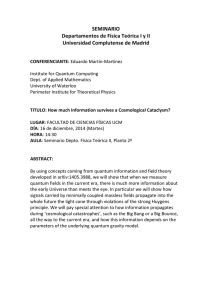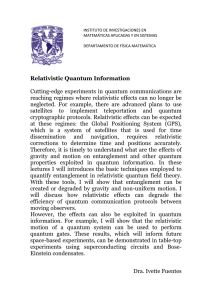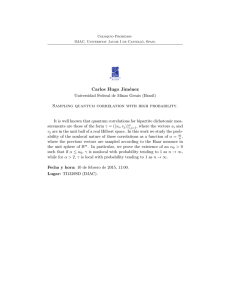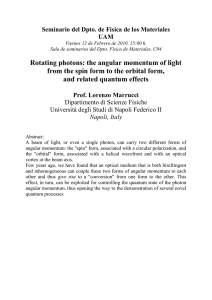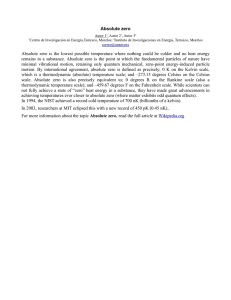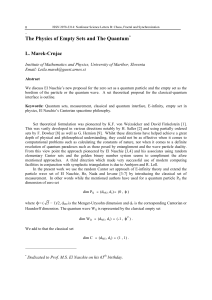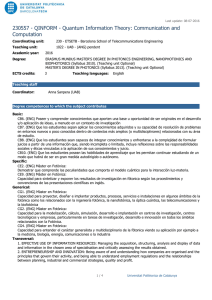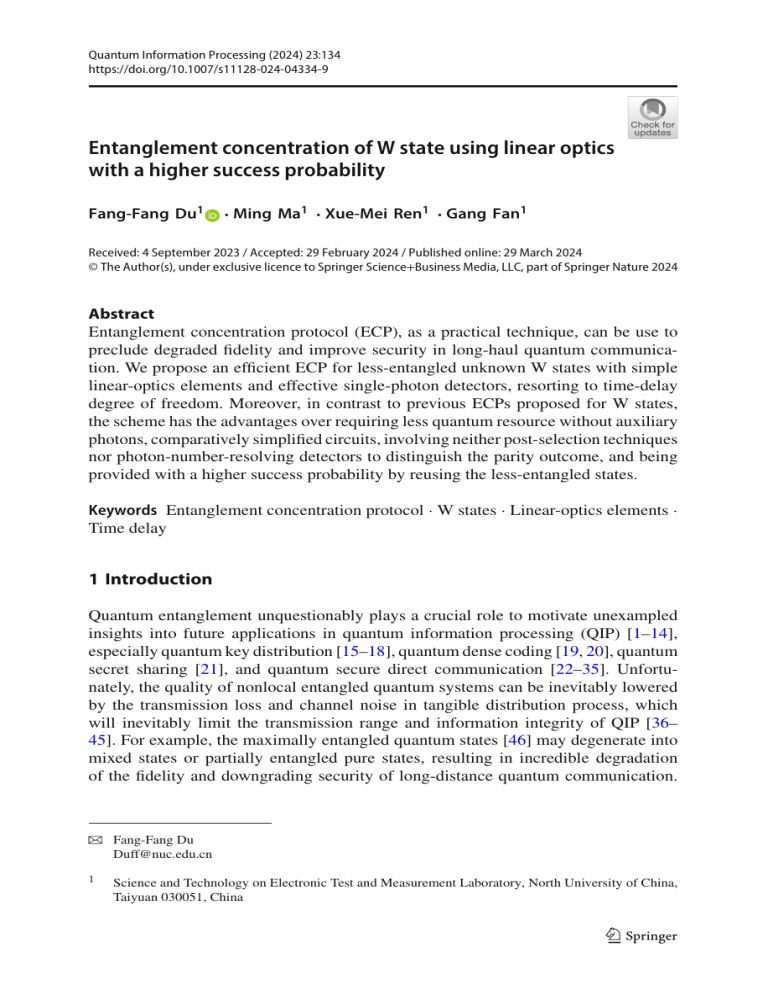
Quantum Information Processing (2024) 23:134 https://doi.org/10.1007/s11128-024-04334-9 Entanglement concentration of W state using linear optics with a higher success probability Fang-Fang Du1 · Ming Ma1 · Xue-Mei Ren1 · Gang Fan1 Received: 4 September 2023 / Accepted: 29 February 2024 / Published online: 29 March 2024 © The Author(s), under exclusive licence to Springer Science+Business Media, LLC, part of Springer Nature 2024 Abstract Entanglement concentration protocol (ECP), as a practical technique, can be use to preclude degraded fidelity and improve security in long-haul quantum communication. We propose an efficient ECP for less-entangled unknown W states with simple linear-optics elements and effective single-photon detectors, resorting to time-delay degree of freedom. Moreover, in contrast to previous ECPs proposed for W states, the scheme has the advantages over requiring less quantum resource without auxiliary photons, comparatively simplified circuits, involving neither post-selection techniques nor photon-number-resolving detectors to distinguish the parity outcome, and being provided with a higher success probability by reusing the less-entangled states. Keywords Entanglement concentration protocol · W states · Linear-optics elements · Time delay 1 Introduction Quantum entanglement unquestionably plays a crucial role to motivate unexampled insights into future applications in quantum information processing (QIP) [1–14], especially quantum key distribution [15–18], quantum dense coding [19, 20], quantum secret sharing [21], and quantum secure direct communication [22–35]. Unfortunately, the quality of nonlocal entangled quantum systems can be inevitably lowered by the transmission loss and channel noise in tangible distribution process, which will inevitably limit the transmission range and information integrity of QIP [36– 45]. For example, the maximally entangled quantum states [46] may degenerate into mixed states or partially entangled pure states, resulting in incredible degradation of the fidelity and downgrading security of long-distance quantum communication. B Fang-Fang Du Duff@nuc.edu.cn 1 Science and Technology on Electronic Test and Measurement Laboratory, North University of China, Taiyuan 030051, China 123 134 Page 2 of 11 F. Du et al. Entanglement purification protocol [47–59], and entanglement concentration protocol (ECP) [60, 61] have been regarded as two efficacious techniques to overcome the above difficulties. In especial, ECPs can be used to distill maximally entangled states from non-maximally entangled pure states available for the imperfect entangled photonic source or entangled decoherence from the quantum storage process. The ECPs for photon systems[61–69, 74–76] have been continuously optimized and developed, e.g., an efficient Kerr-effect-assisted ECP [64], photon-assisted ECPs [65, 66], hyperentanglement-assisted ECPs [67, 68], and linear-optics-assisted ECPs [69]. Sheng et al. set up two single-photon-assisted ECPs for partially entangled photon pairs with known parameters by exploiting linear optics [70] and cross-Kerr-nonlinearities [72, 73], respectively. Sequentially, by orchestrating auxiliary time-delay degree of freedom, Jiang et al. [74] proposed two heralded and high-efficient ECPs for less-entangled Bell and Greenberger-Horne-Zeilinger (GHZ) states with unknown parameters with available linear optics and common single-photon detectors, where postselection techniques or photon-number-resolving detectors are not required and the success probability of ECP for Bell state is exactly heralded by the detection signatures without destroying the incident qubits. Further, they [75] also presented the practically enhanced hyper-ECP for hyperentangled Bell States with a higher success probability than the linear-optics-based hyper-ECP with unknown coefficients [76]. So far, the existing ECPs are mainly directed against distilling partially (hyper)entangled Bell states (or GHZ) states [77–79]. Recently, in view of the commendably intrinsic robustness and meaningful applications of W state in QIP [80], the generation of W entanglement has attracted much attention both in theory and experiment. Consequently, it is considerably valuable to discuss ECP in the partial-entangled W states, e.g., single-photon-assisted [81] ECPs for photon systems in the less-entangled W states [82], ECPs in W states with linear optics [83], cross-Kerr nonlinearity, and cavity-assisted system, have been reported. Sheng et al. first proposed two-step ECPs for arbitrary three-photon W states with known three parameters assisted by two single photons [84]. The second protocol adopting the cross-Kerr nonlinearity through some iteration rounds was higher success probability than the first one with linear optics. In this paper, we propose a high-efficient ECP for unknown less-entangled W states with linear optical elements, resorting to time-delay degree of freedom (DoF). Firstly, compared with the existing ones [82–84], our scheme with unknown coefficients offers a broader range of applications. Secondly, it requires neither photon number-resolving detectors nor post-selection techniques. Thirdly, as the incorporating time-delay DoF enables precise prediction of results from single-photon detectors, three parties can acquire not only the partially entangled state with two new unknown parameters without time interval, but also the standard W state corresponding to time interval, where the partially entangled can be utilized sufficiently with a higher success probability through an iterative process. 2 ECP for unknown W states with linear optics We present an efficient ECP for three-photon less-entangled W states with two unknown parameters by some simple linear-optics elements. With the help of the 123 Entanglement concentration of W state Page 3 of 11 134 time-delay DoF, our ECP can be precisely heralded by the the results of detection without recourse to the post-selection principle. Suppose that two three-photon systems in the maximally entangled W states |φ ABC and |φ A B C are generated from two different entanglement sources S1 and S2 , respectively. 1 |φ ABC = √ (|HVH + |HHV + |VHH) ABC , 3 1 |φ A B C = √ (|HVH + |HHV + |VHH) A B C . 3 (1) Due to the influence of channel noise, the maximally entangled W states decay to the less-entangled W states with two unknown parameters, respectively, i.e., from the states |φ ABC and |φ A B C to that |φ ABC and |φ A B C , respectively, |φ ABC = α|H A |V B |H C + β(|H A |H B |V C + |V A |H B |H C ), |φ A B C = α|H A |V B |H C + β(|H A |H B |V C + |V A |H B |H C ). (2) where the unknown parameters α and β meet the normalization relation α 2 +2β 2 = 1. Thus the state of the composite system composed of six photons A, B, C, A , B and C is |1 = [α|H A |V B |H C + β(|H A |H B |V C + |V A |H B |H C )] ⊗[α|H A |V B |H C + β(|H A |H B |V C + |V A |H B |H C )]. (3) Firstly, as shown in Fig. 1, two photons B and B undergo bit-flip operation through ◦ the HWP45 , i.e., |H |V . The state |1 of the composite system becomes |2 = [α|H A |H B |H C + β(|H A |V B |V C + |V A |V B |H C )] ⊗[α|H A |H B |H C + β(|H A |V B |V C + |V A |V B |H C )]. (4) Secondly, two photons A and B pass through a 50:50 beam splitter (BS), that is, 1 BS | A −→ √ (| A + | B ), 2 1 BS | B −→ √ (| A − | B ). 2 (5) where represents H - or V -polarized state. Then the state |2 evolves into |3 = 1 [α(|H A + |H B )|H B |H C + β(|H A + |H B )|V B |V C 2 + β(|V A + |V B )|V B |H C ] ⊗ [α|H A (|H A − |H B )|H C + β|H A (|V A − |V B )|V C + β|V A (|V A − |V B )|H C . (6) For the convenience of distilling the maximally entangled W state shown in Eq. (6) from the state |3 , Alice, Bob, and Charlie complete the following operations to 123 134 Page 4 of 11 F. Du et al. Fig. 1 Schematic diagram of the ECP for unknown W states. S1 and S2 are two entanglement sources for three-photon systems in the states |φABC and |φ A B C , respectively. BS is a 50:50 beam splitter. PBSi (i = 1, 2, 3, 4, 5, 6, 7) is a polarized beam splitter which transforms the horizontal polarized component |H ◦ ◦ and reflects the vertical polarized one |V . HWP45 and HWP22.5 represent half-wave plates oriented at 45◦ and 22.5◦ , respectively, completing the bit-flip and Hadmard operations. Di (i = 1, 2, 3, 4, 5, 6) is a single-photon detector. The optical circle on the arms denotes time delay t0 or t1 clearly describe this process, according to the Hong-Ou-Mandel effect [85], the state | 3 is rewritten 1 | 3 = √ [α 2 |HHHH A BCC (|HHAA − |HH B B ) + β 2 |HVHV A BCC 2 ⊗ (|VVAA − |VV B B ) + β 2 |VVHH A BCC (|VVAA − |VV B B ) + βα|HVVH A BCC (|HHAA − |HH B B )] 1 + β 2 [|HVVV A BCC (|HVAA − |HV AB + |VH AB − |HV B B ) 2 + |VVVH A BCC (|HVAA − |HV AB + |VH AB − |HV B B )] 1 + αβ[|HHHV A BCC (|HVAA − |HV AB + |VH AB − |HV B B ) 2 +|VHHH A BCC (|HVAA − |HV AB + |VH AB − |HV B B ) + |HVHH A BCC (|HVAA − |HV AB + |VH AB − |HV B B )]. (7) Thirdly, after the photon A(B ) of Alice (Bob) pass through PBS1 (PBS2 ), the H polarized component and V -polarized one pass through the time delays t0 and t1 , respectively. Here t0 and t1 satisfy ω(t0 − t1 ) = 2nπ , where n is the nonzero integer. Then the state | 3 becomes 1 |4 = √ [α 2 |H H H H A BCC (|Ht0 Ht0 A A − |Ht0 Ht0 B B ) 2 + β 2 |HVHV A BCC (|Vt1 Vt1 AA − |Vt1 Vt1 B B ) + β 2 |VVHH A BCC (|Vt1 Vt1 AA − |Vt1 Vt1 B B ) 123 Entanglement concentration of W state Page 5 of 11 134 + βα|HVVH A BCC (|Ht0 Ht0 AA − |Ht0 Ht0 B B )] 1 + β 2 [|HVVV A BCC (|Ht0 Vt1 AA − |Ht0 Vt1 AB 2 + |Vt1 Ht0 AB − |Ht0 Vt1 B B ) + |VVVH A BCC (|Ht0 Vt1 AA − |Ht0 Vt1 AB + |Vt1 Ht0 AB − |Ht0 Vt1 B B )] 1 + αβ[|HHHV A BCC (|Ht0 Vt1 AA − |Ht0 Vt1 AB 2 +|Vt1 Ht0 AB − |Ht0 Vt1 B B ) + |VHHH A BCC (|Ht0 Vt1 AA − |Ht0 Vt1 AB + |Vt1 Ht0 AB − |Ht0 Vt1 B B ) + |HVHH A BCC (|Ht0 Vt1 AA − |Ht0 Vt1 AB + |Vt1 Ht0 AB − |Ht0 Vt1 B B )]. (8) Fourthly, after two photons A and B traverse the PBS3 and PBS4 , respectively, Alice ◦ and Bob perform the Hadmard operation on photons A and B with a HWP22.5 , that is, ◦ 1 HWP22.5 |H −−−−−−→ √ (|H + |V ), 2 ◦ 1 HWP22.5 |V −−−−−−→ √ (|H − |V ). 2 (9) Due to the Hong-Ou-Mandel effect, the final result evolved from |4 to α 4 + 2β 4 + |5 = |ϕ A BC |H C [(|H A |H A + |V A |V A )DAA (0) √ 2 2 − (|H B |H B + |V B |V B )D B B (0)] α 4 + 2β 4 − + |ϕ A BC |H C [2|H A |V A DAA (0) − 2|H B |V B D B B (0)] √ 2 2 √ 3αβ + √ |φ+ A BC |H C [(|H t0 |H t1 ) A A − 2(|H t0 |V t1 ) A A 2 2 − (|V t0 |V t1 )AA − (|H t0 |H t1 ) B B + 2(|H t0 |V t1 ) B B + (|V t0 |V t1 ) B B ] 1 + √ αβ|H A |V B |H C |V C [(|H t0 |H t0 )AA + 2(|H t0 |V t0 )AA 2 2 + (|V t0 |V t0 )AA − (|H t0 |H t0 ) B B − 2(|H t0 |V t0 ) B B − (|V t0 |V t0 ) B B ] 1 + √ β 2 |H A |V B |V C |V C (|H t0 |H t1 )AA − 2(|H t0 |V t1 )AA 2 2 − (|V t0 |V t1 )AA − (|H t0 |H t1 ) B B 123 134 Page 6 of 11 F. Du et al. + 2(|H t0 |V t1 ) B B + (|V t0 |V t1 ) B B ] 1 + √ β 2 |V A |V B |H C |V C [(|H t0 |H t1 )AA − 2(|H t0 |V t1 )AA 2 2 − (|V t0 |V t1 )AA − (|H t0 |H t1 ) B B + 2(|H t0 |V t1 ) B B + (|V t0 |V t1 ) B B ]. (10) where 1 |φ+ A BC = √ (|H A |V B |H C + |H A |H B |V C + |V A |H B |H C ). 3 |ϕ+ A BC = α |H A |H B |H C + β (|H A |V B |V C + |V A |V B |H C ), |ϕ− A BC = α |H A |H B |H C − β (|H A |V B |V C + |V A |V B |H C ), (11) with α = √ 4α 2 α +2β 4 and β = √ 4β 2 α +2β 4 . Here D A A (0) (D B B (0)) represents that there is no relative time delay with regard to the photon A (B ). That means that the single-photon detector (D1 , D2 , D3 , or D4 ) responses without time interval. Finally, after three photons A, B and C go away PBS5 , PBS6 , and PBS7 , respectively, they are measured on the basis (|H , |V ) with single-photon detectors D1 , D2 , D3 , D4 , D5 , or D6 . The relationship between the response outcomes of the singlephoton detector, the corresponding output states, the feed-forward operation on photon B, and the success probability of the corresponding output states is shown in Table 1. It is worth noting that the measurement result of photon C can indicate whether our ECP is successful or not. In detail, if the detector D6 responds, the ECP fails with the probability |αβ|2 + 2|β|4 . Conversely, if the detector D5 responds, the ECP successes. Moreover, if the detector pair (Di , D j ) (i, j = 1, 2, 3, 4) trigger with a specific time interval |t0 − t1 |, the desired maximally entangled W state |φ+ A BC with 2 the success probability of P = 3|αβ| can get without arbitrary feed-forward operation. Otherwise, it means that detector pair (Di , D j ) fire without time interval. In such case, they can get again the less-entangled W state |ϕ+ A BC with the probability of (|α|4 + 2|β|4 )/2, as the state |ϕ− can be transformed into the one |ϕ+ A BC A BC by applying π/2-phase shifter to operate on the polarized state |V B with the same probability. Obviously, after the state |ϕ+ A BC is similar to Eq. (4), which can be further condensed to obtain the state |φ+ A BC in the next round. Therefore, the success probability of the ECP can be increased by recycling state |ϕ+ A BC , and its probability is 4 (|α|4 + 2|β|4 ) · 3|α β |2 = |α|3|αβ| 4 +2|β|4 in the second round. Figure 2 shows the success probability P of our proposed scheme vs the parameter α (β = 21 (1 − α 2 )) in the first round (n = 1) and second round (n = 2), respectively. The maximum success probability has increased from 0.37 to 0.51. 123 Entanglement concentration of W state Page 7 of 11 134 Table 1 The relationship between the detector response, corresponding output results, and the operation on photon B required to complete ECP. The operation σz = |H H | − |V V | can be accomplished with a half-wave plate oriented at 0◦ Single-photon detectors D1 , D2 , D3 , D4 D5 (D1 , D2 ), (D3 , D4 ) t t t t (D10 , D11 ), (D10 , D21 ) t0 t1 t0 t (D2 , D2 ), (D3 , D31 ) t t t t (D30 , D41 ), (D40 , D41 ) t Output results Operation on photon B Success probability |ϕ+ A BC None (|α|4 + 2|β|4 ) |ϕ− A BC + |φ A BC σz None 3|αβ|2 t (Di 0 , D j0 ) (i,j = 1,2,3,4) indicates that (Di , D j ) triggers with a time interval of |t0 − t1 | Fig. 2 The success probability P of our ECP vs the parameter α in the first round (n = 1) and second round (n = 2), respectively 3 Discussion and summary The impact of channel noise on the maximally entangled two-particle and three-particle states (e.g., Bell states, GHZ states, or W states) cannot be negligible in the longdistance QIP. Fortunately, entanglement concentration, as a practical technique, can be use to preclude degraded fidelity and improve security. As the environmental decoherence makes the information of the less-entangled state uncertain, the ECP with unknown parameters is relatively more practical than that with known parameters. However, the success probabilities of the existing ECPs for unknown less-entangled states based on only linear optics are low originated from two fundamental challenges. One is that PBSs can complete parity-check outcomes with the help of photon-numberresolving detectors, which are difficult in experiment by inefficiency. The other one is unable to recycle the concentration process, as the photon pair coincide at the same detector leading to the destructive measurements. Nowadays, we have proposed the ECP for the W state with two unknown parameters assisted by time-delay DoF. At first, if the detector D6 to the photon C responds, the ECP fails and this case is discarded. Otherwise, if the detector D5 responds, the ECP successes. Moreover, as the detectors (Di , D j ) (i, j = 1, 2, 3, 4) to two photons 123 134 Page 8 of 11 F. Du et al. A and B can accurately distinguish the case with absence of time delay (|Ht0 Ht0 AA , |Ht0 |Vt0 AA , |Vt0 |Vt0 AA , |Ht0 |Ht0 B B , |Ht0 |Vt0 B B , |Vt0 |Vt0 B B ) from the one (|Ht0 |Ht1 AA , |Ht0 |Vt1 AA , |Vt0 |Vt1 AA , |Ht0 |Ht1 B B , |Ht0 |Vt1 B B , |Vt0 |Vt1 B B ) with occurrence of time interval |t0 − t1 |, the former is accompanied by the lessentangled W state |ϕ+ A BC with given feed-forward operation and the latter is the standard W state |φ+ A BC without arbitrary feed-forward operation in sequence. Fur+ ther, the state |ϕ A BC can be reused in the next round of the ECP available for increasing success probability. In conclusion, we propose a high-efficient ECP for unknown less-entangled W states by utilizing only linear optical elements, resorting to time-delay DoF. It has some advantages compared with the existing ECPs with known coefficients [82–84]. Firstly, our scheme with unknown coefficients except precise coefficients α and β offers a broader range of applications. Secondly, auxiliary photon, photon number-resolving detectors, and post-selection techniques do not require. Thirdly, as the incorporating time-delay DoF enables precise prediction of results from single-photon detectors, three parties can acquire not only the partially entangled |ϕ+ A BC state with two new unknown parameters without time interval, but also the standard W state |φ+ A BC corresponding to time interval |t0 − t1 |, where the partially entangled |ϕ+ can be A BC recycled in the second round of the ECP improving the success probability from 0.37 to 0.51. Therefore, these characteristics make our ECP highly applicable with current technology and promising for long-distance QIP applications and future advancements. Declarations Conflict of interest The authors declare that they have no known competing financial interests or personal relationships that could have appeared to influence the work reported in this paper. References 1. Nielsen, M.A., Chuang, I.L.: Quantum computation and quantum information. Am. J. Phys. 70, 558 (2002) 2. Wu, Y.M., Fan, G., Du, F.F.: Error-detected three-photon hyperparallel Toffoli gate with state-selective reflection. Front. Phys. 17, 51502 (2022) 3. Du, F.F., Ma, M., Ren, X.M., Fan, G., Du, X.S., Li, L.H., Fan, Z.G., Guo, J.: Deterministic conversion of hyperentangled states with error-heralded quantum units. Ann. Phys. 2300455 (2024) 4. Cao, C., Zhang, L., Han, Y.H., Yin, P.P., Fan, L., Duan, Y.W., Zhang, R.: Complete and faithful hyperentangled-Bell-state analysis of photon systems using a failure-heralded and fidelity-robust quantum gate. Opt. Express 28, 2857 (2020) 5. Du, F.F., Ren, X.M., Fan, Z.G., Li, L.H., Du, X.S., Ma, M., Fan, G., Guo, J.: Decoherence-freesubspace-based deterministic conversions for entangled states with heralded robust-fidelity quantum gates. Opt. Express 32, 1686 (2024) 6. Zhou, Y.R., Zhang, Q.F., Liu, F.F., Han, Y.H., Gao, Y.P., Fan, L., Zhang, R., Cao, C.: Controllable nonreciprocal phonon laser in a hybrid photonic molecule based on directional quantum squeezing. Opt. Express 32, 2786 (2024) 7. Li, T., Wang, Z.K., Xia, K.Y.: Multipartite quantum entanglement creation for distant stationary systems. Opt. Express 28, 1316 (2020) 8. Du, F.F., Ren, X.M., Ma, M., Fan, G.: Complete conversion of KLM entanglement to GHZ entanglement with error-detected quantum devices. Appl. Phys. Express 16, 102006 (2023) 123 Entanglement concentration of W state Page 9 of 11 134 9. Han, Y.H., Cao, C., Fan, L., Zhang, R.: Heralded high-fidelity quantum hyper-CNOT gates assisted by charged quantum dots inside single-sided optical microcavities. Opt. Express 29, 20045 (2021) 10. Du, F.F., Wu, Y.M., Fan, G.: Refined quantum gates for -type atom-photon hybrid systems. Adv. Quantum Technol. 6, 2300090 (2023) 11. Du, F.F., Wu, Y.M., Fan, G., Ma, Z.M.: High-fidelity and low-cost hyperparallel quantum gates for photon systems via -type systems. Ann. Phys. 535, 2200507 (2023) 12. Zhang, XYu., Cao, C., Gao, Y.P., Fan, L., Zhang, R., Wang, C.: Generation and manipulation of phonon lasering in a two-drive cavity magnomechanical system. New J. Phys. 25, 053039 (2023) 13. Du, F.F., Fan, G., Wu, Y.M.: Implementations of heralded quantum Toffoli and Fredkin gates assisted by waveguide-mediated photon scattering. Quantum Inf. Process 22, 55 (2023) 14. Du, F.F., Shi, Z.R.: Robust hybrid hyper-controlled-not gates assisted by an input-output process of low-Q cavities. Opt. Express 27, 17493 (2019) 15. Ekert, A.K.: Quantum cryptography based on Bell’s theorem. Phys. Rev. Lett. 67, 661 (1991) 16. Bennett, C.H., Brassard, G.: Quantum cryptography: public key distribution and coin tossing. Theor. Comput. Sci. 560, 7 (2014) 17. Kwek, L.C., Cao, L., Luo, W., Wang, Y.X., Sun, S.H., Wang, X.B., Liu, A.Q.: Chip-based quantum key distribution. AAPPS Bull. 31, 15 (2021) 18. Huang, J.S., Chen, X.J., Li, X.D., Wang, J.W.: Chip-based photonic graph states. AAPPS Bull. 33, 14 (2023) 19. Bennett, C.H., Wiesner, S.J.: Communication via one- and two-particle operators on Einstein-PodolskyRosen states. Phys. Rev. Lett. 69, 2881 (1992) 20. Liu, X.S., Long, G.L., Tong, D.M., Li, F.: General scheme for superdense coding between multiparties. Phys. Rev. A 65, 022304 (2002) 21. Hillery, M., Bužek, V., Berthiaume, A.: Quantum secret sharing. Phys. Rev. A 59, 1829 (1999) 22. Long, G.L., Liu, X.S.: Theoretically efficient high-capacity quantum-key-distribution scheme. Phys. Rev. A 65, 032302 (2002) 23. Li, T., Long, G.L.: Quantum secure direct communication based on single-photon Bell-state measurement. New J. Phys. 22, 063017 (2020) 24. Qi, Z.T., Li, Y.H., Huang, Y.W., Feng, J., Zheng, Y.L., Chen, X.F.: A 15-user quantum secure direct communication network. Light Sci. Appl. 10, 183 (2021) 25. Long, G.L., Zhang, H.R.: Drastic increase of channel capacity in quantum secure direct communication using masking. Sci. Bull. 66, 1267 (2021) 26. Sheng, Y.B., Zhou, L., Long, G.L.: One-step quantum secure direct communication. Sci. Bull. 67, 367 (2022) 27. Chen, S.S., Zhou, L., Zhong, W., Sheng, Y.B.: Three-step three-party quantum secure direct communication. Sci. China Phys. Mech. 61, 90312 (2018) 28. Wu, X.D., Zhou, L., Zhong, W., Sheng, Y.B.: High-capacity measurement-device-independent quantum secure direct communication. Quantum Inf. Process. 19, 354 (2020) 29. Hong, Y.P., Zhou, L., Zhong, W., Sheng, Y.B.: Measurement-device-independent three-party quantum secure direct communication. Quantum Inf. Process. 22, 111 (2023) 30. Cao, Z.W., Lu, Y., Chai, G., Yu, H., Liang, K.X., Wang, L.: Realization of quantum secure direct communication with continuous variable. Research 6, 0193 (2023) 31. Pan, D., Song, X.T., Long, G.L.: Free-space quantum secure direct communication: basics, progress, and outlook. Adv. Devices Instrum. 4, 0004 (2023) 32. Wu, J.W., Long, G.L., Hayashi, M.: Quantum secure direct communication with private dense coding using a general preshared quantum state. Phys. Rev. Appl. 17, 064011 (2022) 33. Li, X.J., Pan, D., Long, G.L., Hanzo, L.: Single-photon-memory measurement-device-independent quantum secure direct communication-part I: its fundamentals and evolution. IEEE Commun. Lett. 27, 1055 (2023) 34. Li, X.J., Pan, D., Long, G.L., Hanzo, L.: Single-photon-memory measurement-device-independent quantum secure direct communication-part II: a practical protocol and its secrecy capacity. IEEE Commun. Lett. 27, 1060 (2023) 35. Sun, Z.Z., Pan, D., Ruan, D., Long, G.L.: One-sided measurement-device-independent practical quantum secure direct communication. J. Light. 41, 4680 (2023) 36. Cao, C., Duan, Y.W., Chen, X., Zhang, R., Wang, T.J., Wang, C.: Implementation of single-photon quantum routing and decoupling using a nitrogen-vacancy center and a whispering-gallery-mode resonator-waveguide system. Opt. Express 25, 16931 (2017) 123 134 Page 10 of 11 F. Du et al. 37. Wang, B.X., Tao, M.J., Ai, Q., Xin, T., Lambert, N., Ruan, D., Cheng, Y.C., Nori, F., Deng, F.G., Long, G.L.: Efficient quantum simulation of photosynthetic light harvesting. NPJ Quantum Inf. 4, 52 (2018) 38. Jiang, G.L., Yuan, J.B., Liu, W.Q., Wei, H.R.: Efficient and deterministic high-dimensional controlledswap gates on hybrid linear optical systems with high fidelity. Phys. Rev. Appl. 21, 014001 (2024) 39. Ai, Q., Li, P.B., Qin, W., Zhao, J.X., Sun, C.P., Nori, F.: The NV metamaterial: tunable quantum hyperbolic metamaterial using nitrogen vacancy centers in diamond. Phys. Rev. B 22, 014109 (2021) 40. Liu, W.Q., Wei, H.R.: Linear optical universal quantum gates with higher success probabilities. Adv. Quantum Technol. 6, 2300009 (2023) 41. Liu, W.Q., Wei, H.R., Kwek, L.C.: Universal quantum multi-qubit entangling gates with auxiliary spaces. Adv. Quantum Technol. 5, 2100136 (2022) 42. Liu, W.Q., Wei, H.R.: Optimal synthesis of the Fredkin gate in a multilevel system. New J. Phys. 22, 063026 (2020) 43. Liu, W.Q., Wei, H.R., Kwek, L.C.: Low-cost Fredkin gate with auxiliary space. Phys. Rev. Appl. 14, 054057 (2020) 44. Huang, H.L., Xu, X.Y., Guo, C., Tian, G.J., Wei, S.J., Sun, X.M., Bao, W.S., Long, G.L.: Near-term quantum computing techniques: variational quantum algorithms, error mitigation, circuit compilation, benchmarking and classical simulation. Sci. China Phys. Mech 66, 250302 (2023) 45. Long, G.L., Pan, D., Sheng, Y.B., Xue, Q.K., Lu, J.H., Hanzo, L.: An evolutionary pathway for the quantum internet relying on secure classical repeaters. IEEE Netw. 36, 82 (2022) 46. Du, F.F., Ren, X.M., Ma, M., F, G.: Qudit-based high-dimensional controlled-not gate. Opt. Lett. 49, 1229–1232 (2024) 47. Bennett, C.H., Brassard, G., Popescu, S., Schumacher, B., Smolin, J.A., Wootters, W.K.: Purification of noisy entanglement and faithful teleportation via noisy channels. Phys. Rev. Lett. 76, 722 (1996) 48. Du, F.F., Liu, Y.T., Shi, Z.R., Liang, Y.X., Tang, J., Liu, J.: Efficient hyperentanglement purification for three-photon systems with the fidelity-robust quantum gates and hyperentanglement link. Opt. Express 27, 27046 (2019) 49. Yan, P.S., Zhou, L., Zhong, W., Sheng, Y.B.: Feasible measurement-based entanglement purification in linear optics. Opt. Express 29, 9363 (2021) 50. Yan, P.S., Zhou, L., Zhong, W., Sheng, Y.B.: Measurement-based entanglement purification for entangled coherent states. Front. Phys. 17, 21501 (2022) 51. Huang, C.X., Hu, X.M., Liu, B.H., Zhou, L., Sheng, Y.B., Li, C.F., Guo, G.C.: Experimental one-step deterministic polarization entanglement purification. Sci. Bull. 67, 593 (2022) 52. Yan, P.S., Zhou, L., Zhong, W., Sheng, Y.B.: Advances in quantum entanglement purification. Sci. China Phys. Mech. 66, 250301 (2023) 53. Wang, P., Zhang, Z., Yu, C.Q., Yuan, R.Y., Du, F.F., Ren, B.C.: Measurement-based hyperentanglement distillation for lossy and distortion photon state. Ann. Phys. 535, 2200505 (2023) 54. Wu, X.D., Zhou, L., Zhong, W., Sheng, Y.B.: Purification of the concatenated Greenberger-HorneZeilinger state with linear optics. Quantum Inf. Process. 17, 255 (2018) 55. Zhou, L., Liu, Z.K., Xu, Z.X., Cui, Y.L., Ran, H.J., Sheng, Y.B.: Economical multi-photon polarization entanglement purification with Bell state. Quantum Inf. Process. 20, 257 (2021) 56. Luo, C.C., Zhou, L., Zhong, W., Sheng, Y.B.: Purification for hybrid logical qubit entanglement. Quantum Inf. Process. 21, 300 (2022) 57. Zhou, L., Zhong, W., Sheng, Y.B.: Purification of the residual entanglement. Opt. Express 28, 2291 (2020) 58. Wang, P., Yu, C.Q., Wang, Z.X., Yuan, R.Y., Du, F.F., Ren, B.C.: Hyperentanglement-assisted hyperdistillation for hyper-encoding photon system. Front. Phys. 17, 31501 (2021) 59. Du, F.F., Fan, G., Wu, Y.M., Ren, B.C.: Faithful and efficient hyperentanglement purification for spatial-polarization-time-bin photon system. Chin. Phys. B 32, 060304 (2023) 60. Fan, G., Ren, X.M., Du, F.F.: Compact entanglement concentration for three-electron-spin W states with error-detected parity-check gates. Laser Phys. 33, 085202 (2023) 61. Bennett, C.H., Bernstein, H.J., Popescu, S., Schumacher, B.: Concentrating partial entanglement by local operations. Phys. Rev. A 53, 2046 (1996) 62. Zhao, Z., Pan, J.W., Zhan, M.S.: Practical scheme for entanglement concentration. Phys. Rev. A 64, 014301 (2001) 63. Ren, B.C., Long, G.L.: General hyperentanglement concentration for photon systems assisted by quantum-dot spins inside optical microcavities. Opt. Express 22, 6547 (2014) 123 Entanglement concentration of W state Page 11 of 11 134 64. Sheng, Y.B., Deng, F.G., Zhou, H.Y.: Nonlocal entanglement concentration scheme for partially entangled multipartite systems with nonlinear optics. Phys. Rev. A 77, 062325 (2008) 65. Sheng, Y.B., Zhou, L., Zhao, S.M., Zheng, B.Y.: Efficient single-photon-assisted entanglement concentration for partially entangled photon pairs. Phys. Rev. A 85, 012307 (2012) 66. Deng, F.G.: Optimal nonlocal multipartite entanglement concentration based on projection measurements. Phys. Rev. A 85, 022311 (2012) 67. Han, K.Q., Zhou, L., Zhong, W., Sheng, Y.B.: Measurement-device-independent quantum dialogue based on hyperentanglement. Quantum Inf. Process. 20, 280 (2021) 68. Li, Y.P., Zhang, J., Xu, B.W., Zhou, L., Zhong, W., Sheng, Y.B.: Entanglement-assisted noiseless linear amplification for arbitrary two-photon polarization-time-bin hyperentanglement. Quantum Inf. Process. 19, 261 (2020) 69. Takashi, Y., Masato, K., Nobuyuki, I.: Concentration and purification scheme for two partially entangled photon pairs. Phys. Rev. A 64, 022311 (2001) 70. Yang, G., Zhang, Y.S., Yang, Z.R., Zhou, L., Sheng, Y.B.: Linear-optical heralded amplification protocol for two-photon spatial-mode-polarization hyperentangled state. Quantum Inf. Process. 18, 317 (2019) 71. Du, F.F., Fan, G., Ren, X.M., Ma, M.: Deterministic hyperparallel control gates with weak kerr effects. Adv. Quantum Technol. 6, 2300201 (2023) 72. Zheng, Y.B., Zhou, X.J., Wei, H.R., Du, F.F., Song, G.Z.: Schemes for fusing photonic W-state simultaneously without qubit loss via weak cross-Kerr nonlinearities. Quantum Inf. Process. 20, 273 (2021) 73. Du, F.F., Fan, G., Wu, Y.M.: Refined Fredkin gate assisted by cross-Kerr nonlinearity. Opt. Commun 546, 129795 (2023) 74. Jiang, G.L., Liu, W.Q., Wei, H.R.: Heralded and high-efficient entanglement concentrations based on linear optics assisted by time-delay degree of freedom. Opt. Express 30, 47836 (2022) 75. Jiang, G.L., Liu, W.Q., Wei, H.R.: Practically enhanced hyperentanglement concentration for polarization-spatial hyperentangled bell states with linear optics and common single-photon detectors. Phys. Rev. A 19, 034044 (2023) 76. Ren, B.C., Du, F.F., Deng, F.G.: Hyperentanglement concentration for two-photon four-qubit systems with linear optics. Phys. Rev. A 88, 012302 (2013) 77. Zhou, X.J., Liu, W.Q., Zheng, Y.B., Wei, H.R., Du, F.F.: Complete hyperentangled bell states analysis for polarization-spatial-time-bin degrees of freedom with unity fidelity. Ann. Phys. 534, 2100509 (2022) 78. Ding, S.P., Zhou, L., Zhong, W., Sheng, Y.B.: Construction of quantum gates for concatenated Greenberger-Horne-Zeilinger-type logic qubit. Quantum Inf. Process. 17, 306 (2018) 79. Zhou, X.J., Liu, W.Q., Wei, H.R., Zheng, Y.B., Du, F.F.: Deterministic and complete hyperentangled Bell states analysis assisted by frequency and time interval degrees of freedom. Front. Phys. 17, 41502 (2022) 80. Xu, J.S., Li, C.F.: Quantum integrated circuit: classical characterization. Sci. Bull. 60, 141 (2015) 81. Cao, C., Chen, X., Duan, Y.W., Fan, L., Zhang, R., Wang, T.J., Wang, C.: Concentrating partially entangled W-class states on nonlocal atoms using low-Q optical cavity and linear optical elements. Sci. China Phys. Mech. 59, 100315 (2016) 82. Sheng, Y.B., Pan, J., Guo, R., Zhou, L., Wang, L.: Efficient N-particle W state concentration with different parity check gates. Sci. China Phys. Mech. 58, 060301 (2015) 83. Du, F.F., Deng, F.G.: Heralded entanglement concentration for photon systems with linear-optical elements. Sci. China Phys. Mech. 58, 040303 (2015) 84. Sheng, Y.B., Zhou, L., Zhao, S.M.: Efficient two-step entanglement concentration for arbitrary W states. Phys. Rev. A 85, 042302 (2012) 85. Hong, C.K., Ou, Z.Y., Mandel, L.: Measurement of subpicosecond time intervals between two photons by interference. Phys. Rev. Lett. 59, 2044 (1987) Publisher’s Note Springer Nature remains neutral with regard to jurisdictional claims in published maps and institutional affiliations. Springer Nature or its licensor (e.g. a society or other partner) holds exclusive rights to this article under a publishing agreement with the author(s) or other rightsholder(s); author self-archiving of the accepted manuscript version of this article is solely governed by the terms of such publishing agreement and applicable law. 123
